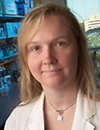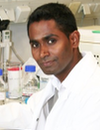Other Track AgendasBiofluid Biopsies | High-Value Diagnostics |

Monday, 16 November 201508:00 | Conference Registration, Coffee, and Breakfast Pastries | |
Session Title: Opening Plenary Session |
| | 09:00 |  | Keynote Presentation Liquid Biopsies in the Management of Cancer
Ellen Beasley, Senior Vice President, Genomic Health Inc, United States of America
Solid tumors that originate in internal organs such as the breast, lung,
or bladder often release DNA and tumor cells into the bloodstream or
urine. When the presence of tumor-derived DNA in blood is high and
persists or increases over time, the cancer is likely growing and a new
course of treatment may be appropriate. The ability to reliably measure
tumor burden in blood and the evolution of tumor biology over time it
will have a transformational impact on the management of cancer.
Patients could forego more invasive procedures like tissue biopsies and
would not have to wait months to do screenings like PET scans. In
real-time management of cancer patients, similar to cholesterol
monitoring, we will have the opportunity to guide patients to the right
treatment with the right dose more quickly, improving patient outcomes
and potentially avoiding unnecessary side effects and cost. |
| 09:30 |  | Keynote Presentation Liquid Biopsies and the Potential to Make Tissue Less of an Issue
Walter Koch, Vice President, Roche Molecular Systems, United States of America
Blood-based testing can reduce test turnaround time and potentially serve as a surrogate for tissue for biopsy ineligible or fragile patients, for whom a tissue sample is not available. Potential uses being explored in clinical studies and trials include 1) identification of genetic determinants that direct targeted therapies (eg EGFR activating mutations in NSCLC for several tyrosine kinase inhibitors), 2) evaluation of early treatment responses, 3) monitoring for minimal residual disease and 4) assessment of disease progression and resistance development. Several technologies are in development for blood based analytes including circulating tumor cells, contents of exosomes released by cancer cells, and cell free circulating tumor DNA (ctDNA). This presentation will exemplify the potential power of Liquid Biopsy approaches using ctDNA analyses with data from several clinical studies involving NSCLC patients undergoing targeted therapy treatment.
|
| 10:00 |  | Keynote Presentation Saliva-Based Detection of Actionable EGFR Mutation in Lung Cancer Patients
David Wong, Felix and Mildred Yip Endowed Chair in Dentistry; Director for UCLA Center for Oral/Head & Neck Oncology Research, University of California-Los Angeles, United States of America
Constitutive activation of epithelial growth factor receptor (EGFR) is
prevalent in epithelial cancers, particularly in non-small-cell lung
carcinoma (NSCLC). EGFR mutation predicts sensitivity to EGFR-targeted
therapy and mutation detection is mainly based on tissue biopsy, which
is invasive, expensive and time-consuming. Non-invasive, real-time,
point-of-care, inexpensive detection and monitoring of EGFR mutations in
NSCLC patients is highly desirable. We developed a novel core
technology, Electric Field-Induced Release and Measurement (EFIRM),
relying on a multiplexible electrochemical sensor that can detect EGFR
mutations directly from body fluids. EFIRM for EGFR mutation detection
was established in vitro, and correlated with tumor size from
xenografted mice. In clinical application, we demonstrated that EFIRM
can detect EGFR mutations from saliva and serum of 22 NSCLC patients.
And finally, a blinded test was performed on saliva from 40 NSCLC
patient saliva samples. The receiver operating characteristic analysis
indicated that EFIRM detected the exon 19 deletion with an area under
the curve (AUC) of 0.94 and the L858R mutation with an AUC of 0.96. Our
data indicate that EFIRM is effective, accurate, rapid, user-friendly,
and cost effective for the detection of EGFR mutations in saliva of
NSCLC patients. |
| 10:30 | Coffee Break and Networking | 11:00 |  | Keynote Presentation Plasma Extracellular Vesicle Content for Diagnosis and Prognosis of Cardiovascular Disease
Dominique PV de Kleijn, Professor Experimental Vascular Surgery, Professor Netherlands Heart Institute, University Medical Center Utrecht, The Netherlands, Netherlands
Cardiovascular Disease (CVD) is with the cardiovascular events of
Ischemic Heart Disease and Stroke, the number 1 and 2 cause of death in
the world and expect to increase especially in Asia. Atherosclerosis is
the underlying syndrome for CVD and atherosclerotic plaques are
detectable already in teenagers. Therefore for cardiovascular disease,
we have to determine who is at high risk for a cardiovascular event in a
high-risk background of the atherosclerotic syndrome without the
possibility of taking a plaque biopsy. The risk for Cardiovascular
events is region-dependent so tailored plasma-based biomarkers are
essential to guide prevention and treatment of billions. Collecting
plasma extracellular vesicles is like taking a liquid biopsy from the
pathological tissue that can be used for diagnosis and prognosis of the
disease. We show that plasma extracellular vesicle protein content
especially when collected from different plasma subfractions can be used
as an accurate source for diagnosis and prognosis of cardiovascular
disease. |
| 11:30 |  | Keynote Presentation The Evil Little Things About Cancer: EVs as Infiltrators and Informants
Xandra Breakefield, Professor, Mass General Hospital (MGH)/Harvard Medical School, United States of America
Tumor cells release an abundance of extracellular vesicles which contain protein, RNA and DNA cargo. Studies are actively ongoing to determine the different types of tumor-derived vesicles and the function of their cargo, which appears to be designed to change the phenotype of many types of normal cells in favor of tumor progression. These evil-intentioned vesicles have two possible Achilles’ heels. In the first case, they can be isolated from biofluids of the cancer patient and used to inform on the mutational stratagem of the tumors and hence provide clues as to effective treatment strategies. In the second case, vesicles may be transformed into therapeutic vehicles to “silently” attack the tumors. |
| 12:00 |  | Keynote Presentation The Utility of Blood Exosomes from Cancer Patients as Biomarkers for Early Detection
Raghu Kalluri, Professor and Chairman, Department of Cancer Biology, University of Texas MD Anderson Cancer Center, United States of America
|
| 12:30 | Networking Lunch, Visit the Exhibitors, and Poster Viewing | |
Session Title: Biofluids are the Starting Materials for Developing High-Value Diagnostics |
| | 14:00 |  Technology Spotlight: Technology Spotlight:
Circulating Cell-Free DNA (cfDNA) Analysis in Liquid Biopsies
Theresa Zhang, Vice President, Research Services, Personal Genome Diagnostics
| 14:30 |  | Keynote Presentation Extracellular RNA in Central Nervous System Injury and Disease
Kendall Van Keuren-Jensen, Professor and Deputy Director, Translational Genomics Research Institute, United States of America
Diseases and injuries of the central nervous system are difficult to evaluate or monitor frequently over time. We have been assessing the types of RNAs released from the central nervous system, and its availability for detection in different biofluids. We describe RNA profiles of different biofluids and their correlation with injury and disease. |
| 15:00 | Extracellular RNAs in the Maternal Circulation: A Window into Placental Function
Louise Laurent, Associate Professor, University of California-San Diego, United States of America
Critical to the success of the pregnancy is the rapid development of a
new organ, the placenta, which is of fetal origin, but which must gain
access to the maternal bloodstream. This direct contact between
placental trophoblast cells and the maternal circulation facilitates the
functions of these cells, both as mediators of the exchange of
materials between the fetus and the mother, and as sources of signaling
molecules that induce changes in maternal physiology necessary for the
establishment and maintenance of the pregnancy, such as progesterone,
human chorionic gonadotropin and human placental lactogen. It is
reasonable, then, to hypothesize that both the physiological changes
occurring over the course of normal pregnancy and the pathological
changes taking place with complications of pregnancy, are reflected in
the ExRNA profiles of maternal biofluids, and may even be partially
mediated by ExRNA signals. Here, we will discuss evidence that ExRNAs in
the maternal circulation indeed reflect changes in placental function
during pregnancy. | 15:30 | Coffee Break, Visit Exhibitors and Networking | 16:00 | Extracellular Vesicles in Cancer: Exosomes, Microvesicles and the Emerging Role of Large Oncosomes
Dolores Di Vizio, Professor, Cedars Sinai Medical Center, United States of America
| 16:30 | Monitoring Cancer Through the Blood
Cloud Paweletz, Head of the Translational Research Laboratory, Dana Farber Cancer Institute, United States of America
Genotype-directed targeted therapies are revolutionizing cancer care. Genomic alterations in genes such as EGFR, ALK, KRAS, and BRAF have been validated as powerful predictive biomarkers in the management of non-small cell lung cancer (NSCLC), colorectal cancer, and melanoma; testing for these mutations is currently standard to personalize treatment decisions. The challenges associated with routine use of NGS include availability of adequate tumor specimens, slow turnaround time, and evolving tumor biology in response to treatment that may necessitate a repeat biopsy to guide subsequent therapy. Here we describe the use of blood based, non-invasive technologies to overcome tissue based genomics. | 17:00 | Deep Sequencing Analysis of Exosomal and Non-Exosomal Non-Coding RNA in Human Ovarian Follicular Fluid
Shlomit Kenigsberg, Senior Researcher, Create Fertility Centre, Canada
| 17:30 | Liquid Biopsies – Cancer Disease Profiling with Less Burden on Patients
Klaus Lücke, CEO & Founder, GILUPI GmbH, Germany
Liquid biopsy techniques use markers found in blood such as circulating tumor cells (CTCs) for improving the diagnosis and treatment of cancer. Its’ significant advantage over highly invasive tumor biopsies is the minimal invasiveness and that it can be performed repetitively, thus being well suited for regular monitoring of disease progression and development of disease resistance following treatment.
The GILUPI CellCollector® liquid biopsy device is uniquely capable of gathering patient-specific disease information critical to the achievement of improved clinical outcomes in major therapeutic areas including oncology and cardiovascular disease. GILUPI’s novel in vivo technology has proven highly effective in disease diagnosis, treatment monitoring and drug development via provision of real time biomarker analysis and patient disease data in a minimally invasive manner. | 18:00 | Circulating Tumor Cells via a Novel 4 color FISH Probe for Accurate Diagnosis of Lung Cancer
Ruth Katz, Professor of Pathology, Chief Image Analysis Laboratory, Chief Research Cytopathology, MD Anderson Cancer Center, United States of America
With the advent of early lung cancer diagnosis by spiral CT for small lung nodules, an adjunctive biomarker test that is accurate for diagnosis of malignancy is essential, in order to stratify patients for resection versus observation. We present an overview and results of our antigen independent FISH test, specifically engineered for lung cancer diagnosis, performed in over 100 cases and controls with proven diagnosis of predominantly early lung cancer. We show that this is a highly sensitive and specific test for the diagnosis of all histologic subtypes of lung cancer. Several illustrative cases will be provided. | 18:30 | Cocktail Reception: Premium Beers, California Wines, Appetizers and Networking on the 15th Floor of the Wyndham Boston Beacon Hill with a View of Boston and the Charles River | 20:00 | Close of Day 1 of the Conference. |
Tuesday, 17 November 201507:30 | Morning Coffee, Breakfast Pastries, and Networking | |
Session Title: Creating High-Value Diagnostics which are Minimally-Invasive Using Extracellular Nucleic Acids and Extracellular Vesicles |
| | 08:00 | A Universal Extracellular Vesicle Cancer Screening Test Based on the Warburg Effect
Winston Patrick Kuo, SAB, Exosomics Siena; Editor-in-Chief, Journal of Circulating Biomarkers, InTech Publishers, United States of America
Cancer cells adopt a non-oxidative breakdown of glucose to produce energy, in contrast to healthy cells which mainly generate energy from oxidative breakdown of pyruvate. The underlying driver of tumorigenesis is an impaired cellular respiration caused by a dysfunction of mitochondria. It is has been demonstrated that cancer cells, and many cells grown in-vitro, exhibit glucose fermentation even when enough oxygen is present to properly respire, hence the phenomenon, the Warburg Effect. The presentation discusses the novelty and impact of a membrane protein targeting tumour metabolism along with cancer-specific biomarkers in both circulating and specific sub-populations of extracellular vesicles in most solid tumours (colon, gastric, breast, lung, prostate, ovarian and melanoma) for purposes of screening, diagnostics and monitoring therapeutic treatments. | 08:30 | Tissue Print Technologies: An Innovative and Practical Approach to Obtaining High-quality Research Samples from Biopsies and Other Challenging Biospecimens
Sandra Gaston, Director, Molecular Biomarkers Research Laboratory; Scientific Director, Tufts Medical Center Biorepository, Tufts Medical Center, United States of America
Development of liquid biopsy technologies for use in the clinical management of cancer patients often requires comparisons with tumor tissues. Most human tissue samples obtained from clinical biopsy and surgical resections are only secondarily considered as research specimens, and any plan to collect tissue for research must put first priority on patient care. Remnant tissues obtained from fresh surgical specimens are the mainstay for biorepositories that provide high quality snap-frozen tissues for research, but many critical areas of a surgical resection and most diagnostic biopsies cannot be easily “divvied up” before the tissue is submitted for processing as a formalin-fixed paraffin embedded (FFPE) specimen. Moreover, access to FFPE biospecimens for research is becoming more restricted as clinical molecular testing places increasing demands on those tissue blocks. Our research group has developed a set of tissue print technologies that offer an innovative and practical approach to obtaining high quality RNA and DNA from biopsies and other “high value” specimens without compromising pathology diagnosis. Application of these technologies for cancer biomarker discovery and potential clinical diagnostic applications will be discussed.
| 09:00 | Exosomes: Next Generation Diagnostics
Johan Skog, Chief Scientific Officer, Exosome Diagnostics Inc, United States of America
| 09:30 |  | Keynote Presentation Exosomes in the Pathogenesis and Diagnosis of Alzheimer’s and Neurodegenerative Diseases
Lawrence Rajendran, Velux Stiftung Professor for Systems and Cell Biology of Neurodegeneration, University of Zurich, Switzerland
While they play crucial roles in physiological processes, EVs/exosomes also contribute to the development of disease states. Neurodegenerative diseases including Alzheimer’s (AD), Parkinson’s disease (PD) and Prion diseases, are characterized by protein aggregation and deposition in specific brain regions. While the exact pathological significance of these aggregates remains to be conclusively resolved, the biology behind their formation is unclear. Recent findings, on the release and spread of several amyloid-forming proteins, suggest a model where these proteins can be released from affected cells in the form of amyloid seeds, and then re-enter other cells and aid in the spread of the disease. How are these aggregates released from the cells? Once released, how do they form plaques and propagate in the aqueous extracellular space to gain access to their host counterparts? We propose that exosomes, endocytically derived nanovesicles, are a major way to shuttle amyloids out of the cell and aid in the plaque formation. We provide evidence that Aß is generated in early endosomes and is released in association with exosomes. Immunoelectron microscopy on exosomes showed that Aß peptides not only co-fractionated with exosomes but also are physically associated with them. To investigate whether these findings have any bearing on Alzheimer pathology, we performed immunohistochemistry analysis with antibodies against exosomal proteins on brain sections from AD patients, Parkinson patients and age matched control subjects. Enrichment of Alix, a marker for exosomes, was seen around the small neuritic plaques and a moderate signal in large diffuse plaques in brain sections from all AD patients tested. Alix staining was largely absent in brain sections of control subjects. Similar to Aß, both Tau and a-synuclein are also found in EVs and together this represents a novel mode of amyloid transmissibility presenting opportunity for exosome-based diagnostics.
|
| 10:00 | Carboxypeptidase E: A Prognostic Cancer Biomarker in Tumors and Circulating Exosomes
Y. Peng Loh, Chief and Senior Investigator, Section on Cellular Neurobiology, Eunice Kennedy Shriver National Institute of Child health and Human Development, National Institutes of Health (NIH), United States of America
Carboxypeptidase E (CPE) and/or a splice variant of CPE (CPE-?N) have been reported to be a good prognostic biomarker for hepatocellular carcinoma (HCC), colorectal cancer and glioblastoma. Microarray data from the Gene Expression Omnibus (GEO) profile database have also indicated significant overexpression of CPE mRNA in many different human cancer types compared to normal tissue. These included metastatic non-endocrine cervical cancer, renal (clear cell) carcinoma, Ewing sarcoma, glioblastoma and various types of astrocytomas and oligodendrogliomas. High expression of CPE mRNA was also found in neuroendocrine tumors, such as pheochromocytoma/paraganglioma, (PHEO/PGL), pulmonary neuroendocrine tumors and insulinomas. Circulating exosomes mirror the parent cell. Exosomes derived from cancer cells contain mRNA and protein that reflects the parent tumor. We have detected CPE mRNA in exosomes in cell culture media from cancer cell lines including liver, breast, prostate and colorectal cancer cell lines. We have also isolated exosomes from serum of PHEO/PGL patients and showed that they contain CPE/CPE-?N mRNA. In a pilot study the levels of CPE/CPE-?N mRNA was determined by qRT-PCR in circulating exosomes of cancer patients. There was a significantly elevated level of CPE/CPE-?N mRNA levels compared to normal controls. Since this biomarker is elevated in many types of cancers, a serum assay using circulating exsomes could be very useful for: 1. routine screening of population > 60 y of age for early diagnosis of cancer. 2. screening high risk patients for early detection of many cancers including patients with liver cirrhosis, smokers, men with positive PSA test, women with solid ovarian cysts, or carry the gene for breast cancer, PHEO/PGL patients with inherited gene mutations for the disease; 3. post-surgery screening of Stage I & II patients for early detection of recurrence; 4. in clinical trials to test the efficacy of the cancer treatment. | 10:30 | Coffee Break, Visit the Exhibitors and Networking | 11:00 | Isolating Circulating Cell Free DNA from Plasma and Serum Using MagMAX Cell Free DNA isolation kit
Susan Magdaleno, Sr. Manager, R&D, Thermo Fisher Scientific, United States of America
Cell-free DNA (cfDNA) circulating in blood and other body fluids is a sample type of broad interest in applications for non-invasive detection and monitoring of human cancer and other diseases. cfDNA in body fluids is typically rare in abundance making sample preparation very challenging. Current commercially available methods of preparation do not allow for enrichment of the smaller cfDNA fraction away from the contaminating genomic DNA which may lower sensitivity of detection of the cfDNA. And current workflows for preparing cfDNA from body fluids can be lengthy and cumbersome, especially when processing multiple samples simultaneously. We have developed an easier method to isolate cell free DNA from liquid biopsies. The MagMAX™ cell-free DNA isolation kit is a new magnetic bead-based sample preparation kit designed to enrich for cfDNA using a quick and simple workflow that can be performed manually or using automated platform. The enriched cfDNA is compatible with downstream assays like digital PCR, qPCR and next generation sequencing technologies. The MagMAX™ cell-free DNA workflow and analysis of the isolated cfDNA using various analytical methods will be presented. | 11:30 |  Technology Spotlight: Technology Spotlight:
Maximizing Next Generation Sequencing Capabilities of Circulating, Cell-Free DNA
Tim Harkins, President and CEO, Swift Biosciences
Swift Biosciences presents NGS methods that are cost effective, sensitive, and specific to assess cfDNA. Methods discussed for whole genome sequencing from PCR-free libraries, point mutation detection with hyb/capture and multiplex amplicons, and methylation patterns all from single liquid biopsy samples.
| 12:00 |  | Keynote Presentation The Landscape of Cancer Biomarkers and Challenges and Opportunities for the Translation of Research
Lynn Sorbara, Program Director, National Cancer Institute, United States of America
The talk will be a review the challenges, gaps, and potential clinical utility of liquid biomarkers. |
| 12:30 | Networking Lunch, Visit the Exhibitors and View Posters | 13:00 |  Technology Spotlight: Technology Spotlight:
Luncheon Technology Spotlight: An Effective NGS Workflow for microRNA Profiling from Liquid Biopsies, Extracellular Vesicles and Small Sample Input - Sample Preservation, RNA Extraction, Amplification and Profiling
Bernard Lam, Senior Research Scientist, Norgen Biotek Corporation, Canada
Yousef Haj-Ahmad, President & CEO, Norgen Biotek Corp, Canada
Here, we present an effective workflow for studying miRNAs from various bodily fluids. The workflow involves four important modules - (1) Sample Preservation, (2) RNA Extraction, (3) miRNA Amplification, (4) Detection. Using urine RNA as an example, we demonstrated the importance of preservation as a significant amount of miRNA transcripts could be lost during standard freezing storage. For RNA purification, we demonstrated that the use of silicon carbide-resin technology worked more effectively than traditional phenol:chloroform/silica column-based methods in recovering miRNAs from bodily fluids such as plasma and urine. In particular, the silicon carbide technology does not require the use of carrier RNA and it does not have any bias in GC contents of the miRNAs. Even with effective preservation and RNA extraction, many bodily fluids samples may yield very low amount of RNA (sometimes at the nanogram or picogram range). We will also discuss the methods of quantification of RNA extracted from these liquid biopsies and the expected outcome. Finally, we will present data of a novel procedure that allows amplification of miRNAs from sub-nanogram amount for applications such as RT-qPCR array, microarray and small RNA sequencing.
| |
Session Title: Circulating Biomarkers Heading for Clinical Use? Cancer, Cardiovascular Disease and Fertility |
| | 13:30 | The Role Of The Pathologist In The Measurement Of Circulating Tumor Cells (CTCs): A Pathologist’s Perspective
Malini Harigopal, Associate Professor, Dept of Pathology, Breast and Cytopathology, Yale University, United States of America
The use of Circulating Tumor Cells (CTCs) is a rapidly growing new
diagnostic test to help manage oncology patients. The test is being done
at different institutions, even though it requires morphologic skills
highly similar to those of the cytopathologist. The dramatic reduction
in Pap smear specimens due to molecular technologies leaves potential
capacity in the cytopathology lab. Thus, CTC analysis is an ideal new
test to introduce into the cytopathology practice. After many years of
basic research for assessment of circulating tumor cells (CTCs), there
is now an FDA approved method available for use in clinical labs. The
CellSearch System (Veridex) requires morphology skills highly similar to
those of the cytopathologist to enumerate CTCs. The cytopathology lab
is a natural location for this technology in the healthcare delivery
system. The cytotechnologist under the supervision of the pathologist is
involved in the final interpretation and enumeration of CTC. Molecular
characterization of CTC provides additional prognostic information. | 14:00 |  Technology Spotlight: Technology Spotlight:
The First Cytomic Signature of Vascular Health
Roy Overton, VP, Laboratory Operations, CytoVas, LLC
The CytoVas Vascular Health Profile™ (VHP) is the first-in-class diagnostic and prognostic test, integrating cytomic biomarkers and computational biology to provide a highly precise, cell-based signature of the state of the vascular endothelium and, by extension, vascular health.
| 14:30 | Extracellular Vesicles in Human Reproduction
Clifford Librach, Medical and Scientific Director, CReATe Fertility Centre, Canada
Investigation of the functional role of extracellular vesicles and their RNA content in 4 fluids associated with human reproduction including seminal fluid, follicular fluid, embryo conditioned culture media and pregnancy serum. | 15:00 | Use of ctDNA and CTCs in the Biomarker Identification and Monitoring of Patients with Cancer
Lyle Arnold, Chief Scientific Officer, Biocept, United States of America
Liquid biopsies offer the opportunity to interrogate a number of different target sample types, including ctDNA and CTCs. At Biocept both ctDNA and CTCs are used for identifying medically actionable biomarkers to assist in the optimal treatment of patients. A highly sensitive Target-SelectorTM assay is used for analysis of ctDNA which can detect better than 1:10,000 (mutant:wild-type). At the same time, a patented microchannel is used for isolating and interrogating CTCs at the single cell level. CTCs are enriched up to 50,000 fold and clinically actionable biomarkers are analyzed directly in the microchannel. The combination of these technologies has enabled the clinical validation of an array of biomarkers from single blood samples. These include mutational analysis for EGFR, KRAS, and BRAF, as well as FISH and protein analysis for HER2, FGFR1, MET, ALK, ROS1, ER, and PDL-1 across a range of cancer types. | 15:30 | Novel Technologies for Quantitative Enrichment of Mutations Prior to Targeted Re-Sequencing of Circulating DNA
Mike Makrigiorgos, Professor, Dana-Farber Cancer Institute/Harvard Medical School, United States of America
| |
Panel Discussion |
| | 16:00 | Coffee and Panel Discussion: Challenges for the Implementation of Liquid Biopsies in Clinical Practice -- Issues and Perspectives | 17:00 | Close of Day 2 of the Conference. |
|

 Add to Calendar ▼2015-11-16 00:00:002015-11-17 00:00:00Europe/LondonHigh-Value DiagnosticsSELECTBIOenquiries@selectbiosciences.com
Add to Calendar ▼2015-11-16 00:00:002015-11-17 00:00:00Europe/LondonHigh-Value DiagnosticsSELECTBIOenquiries@selectbiosciences.com